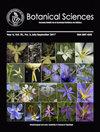Secondary metabolites in Viguiera (Compositae, Heliantheae, Helianthinae) and segregated genera. A review of their biological activities with chemotaxonomic observations
IF 0.7
4区 生物学
Q3 PLANT SCIENCES
引用次数: 0
Abstract
Background: The first monograph of the genus Viguiera was published in 1918 by Blake, including about 141 species. Schilling & Panero based on studies of molecular sequences of nuclear Internal Transcribed Spacer and External Transcribed Spacer, as well as cpDNA, proposed to reclassify the genus, relocating its species in at least other nine genera. Question: Is it possible to identify distinctive patterns between the species of the new classification of Viguiera s. l. and the results of the chemical studies reported? Species considered: Sixty-seven species within the wide Viguiera circumscription with chemical studies and biological activities reported. Results: The species of the genus Viguiera synthesize terpenoids represented mainly by sesquiterpene lactones and diterpenes, with triterpenes, polyacetylenes, volatile terpenoids and flavonoids also present. The main types of secondary metabolites were present in the studied species, although some compounds were more frequent than others in some clades. Conclusion: Germacrolides, heliangolides, furanoheliangolides, tetracyclic diterpenes and flavonoids are the main constituents of Viguiera and segregated genera. Some interesting chemotaxonomic relationships are noted. Nevertheless, nondistinctive clear patterns were observed between clades and chemical groups. These results may be a consequence of the reported chemical studies of the species of Viguiera s. l., which have not agreed on objetives or methodologies.菊科、向日葵科、向日葵科及其分离属的次生代谢物。用化学分类观察综述了它们的生物活性
背景:布雷克于1918年出版了第一本关于维吉拉属的专著,其中包括约141种。Schilling & Panero基于对核内转录间隔器和外转录间隔器分子序列以及cpDNA的研究,提出对该属进行重新分类,将其种重新定位到至少其他9个属中。问题:是否有可能在Viguiera s.l.新分类的物种和已报道的化学研究结果之间识别出独特的模式?考虑的物种:在维吉埃拉范围内的67种,已报道了化学研究和生物活动。结果:该属植物合成的萜类化合物以倍半萜内酯和二萜为主,还含有三萜、聚乙炔、挥发性萜类和黄酮类化合物。次生代谢物的主要类型存在于所研究的物种中,尽管某些化合物在某些进化枝中比其他化合物更常见。结论:大环内酯类、向日葵内酯类、呋喃向日葵内酯类、四环二萜类和黄酮类化合物是维吉拉属和分离属的主要成分。注意到一些有趣的化学分类学关系。然而,在进化枝和化学类群之间观察到的不是明显的清晰模式。这些结果可能是对viguera s.l .物种的化学研究报告的结果,这些研究没有就目标或方法达成一致。
本文章由计算机程序翻译,如有差异,请以英文原文为准。
求助全文
约1分钟内获得全文
求助全文
来源期刊

Botanical Sciences
Agricultural and Biological Sciences-Plant Science
CiteScore
1.90
自引率
21.40%
发文量
71
审稿时长
16 weeks
期刊介绍:
Botanical Sciences welcomes contributions that present original, previously unpublished results in Botany, including disciplines such as ecology and evolution, structure and function, systematics and taxonomy, in addition to other areas related to the study of plants. Research reviews are also accepted if they summarize recent advances in a subject, discipline, area, or developmental trend of botany; these should include an analytical, critical, and interpretative approach to a specific topic. Acceptance for reviews will be evaluated first by the Review Editor. Opinion Notes and Book Reviews are also published as long as a relevant contribution in the study of Botany is explained and supported.
 求助内容:
求助内容: 应助结果提醒方式:
应助结果提醒方式:


